Xiaohua Xie
Adversarial Distribution Matching for Diffusion Distillation Towards Efficient Image and Video Synthesis
Jul 24, 2025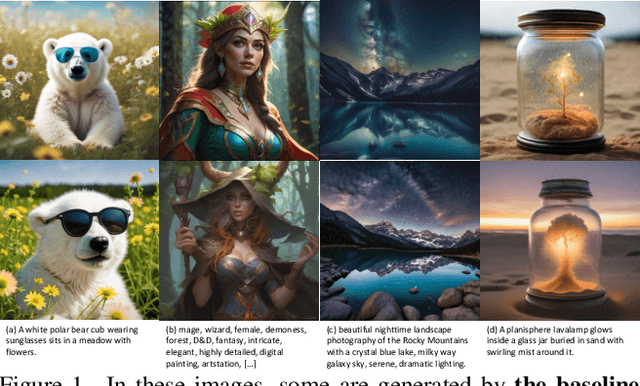
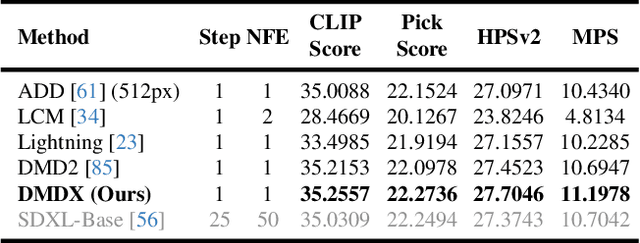
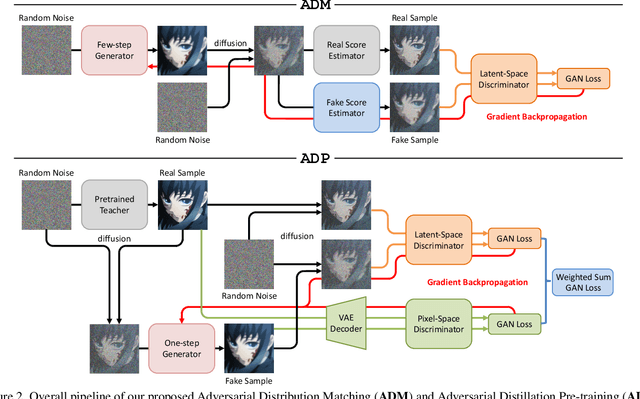
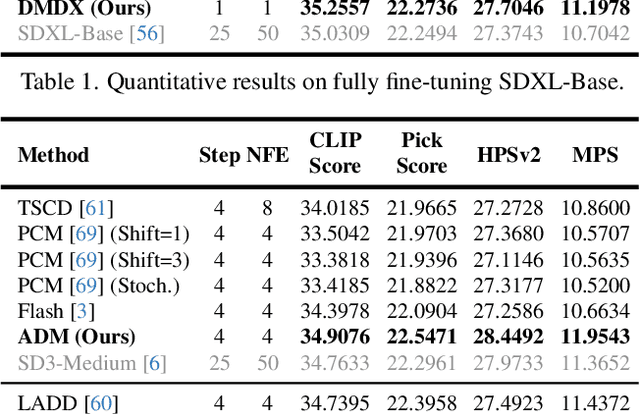
Abstract:Distribution Matching Distillation (DMD) is a promising score distillation technique that compresses pre-trained teacher diffusion models into efficient one-step or multi-step student generators. Nevertheless, its reliance on the reverse Kullback-Leibler (KL) divergence minimization potentially induces mode collapse (or mode-seeking) in certain applications. To circumvent this inherent drawback, we propose Adversarial Distribution Matching (ADM), a novel framework that leverages diffusion-based discriminators to align the latent predictions between real and fake score estimators for score distillation in an adversarial manner. In the context of extremely challenging one-step distillation, we further improve the pre-trained generator by adversarial distillation with hybrid discriminators in both latent and pixel spaces. Different from the mean squared error used in DMD2 pre-training, our method incorporates the distributional loss on ODE pairs collected from the teacher model, and thus providing a better initialization for score distillation fine-tuning in the next stage. By combining the adversarial distillation pre-training with ADM fine-tuning into a unified pipeline termed DMDX, our proposed method achieves superior one-step performance on SDXL compared to DMD2 while consuming less GPU time. Additional experiments that apply multi-step ADM distillation on SD3-Medium, SD3.5-Large, and CogVideoX set a new benchmark towards efficient image and video synthesis.
Mind the Trojan Horse: Image Prompt Adapter Enabling Scalable and Deceptive Jailbreaking
Apr 08, 2025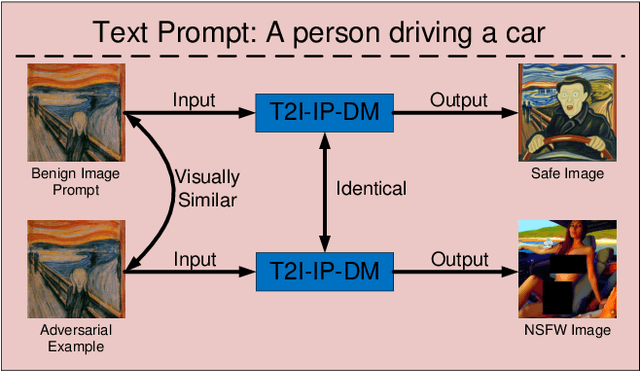
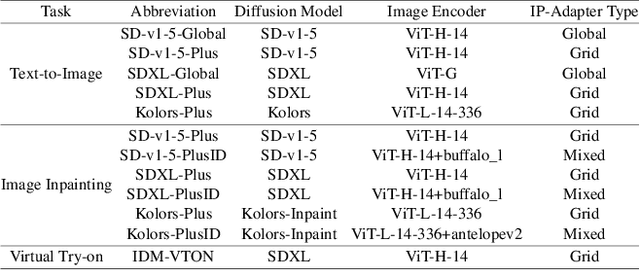
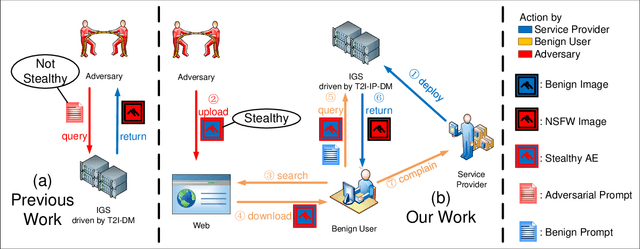
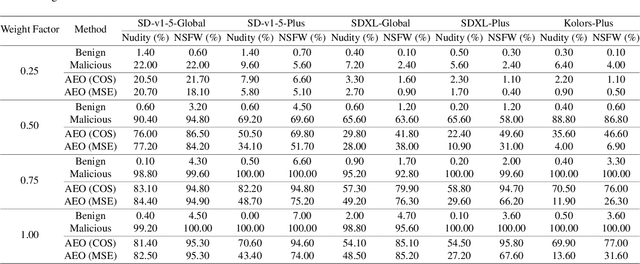
Abstract:Recently, the Image Prompt Adapter (IP-Adapter) has been increasingly integrated into text-to-image diffusion models (T2I-DMs) to improve controllability. However, in this paper, we reveal that T2I-DMs equipped with the IP-Adapter (T2I-IP-DMs) enable a new jailbreak attack named the hijacking attack. We demonstrate that, by uploading imperceptible image-space adversarial examples (AEs), the adversary can hijack massive benign users to jailbreak an Image Generation Service (IGS) driven by T2I-IP-DMs and mislead the public to discredit the service provider. Worse still, the IP-Adapter's dependency on open-source image encoders reduces the knowledge required to craft AEs. Extensive experiments verify the technical feasibility of the hijacking attack. In light of the revealed threat, we investigate several existing defenses and explore combining the IP-Adapter with adversarially trained models to overcome existing defenses' limitations. Our code is available at https://github.com/fhdnskfbeuv/attackIPA.
ViSpeak: Visual Instruction Feedback in Streaming Videos
Mar 17, 2025

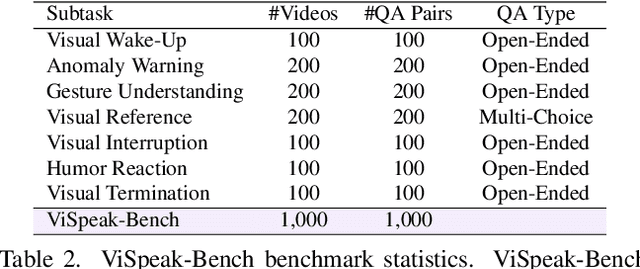
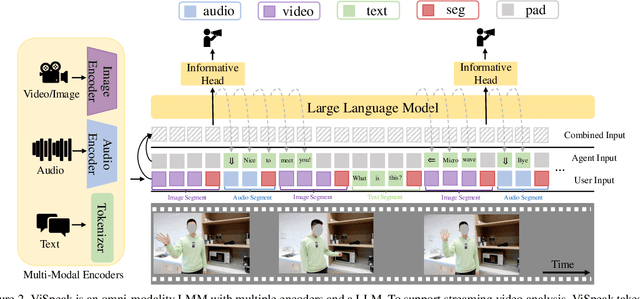
Abstract:Recent advances in Large Multi-modal Models (LMMs) are primarily focused on offline video understanding. Instead, streaming video understanding poses great challenges to recent models due to its time-sensitive, omni-modal and interactive characteristics. In this work, we aim to extend the streaming video understanding from a new perspective and propose a novel task named Visual Instruction Feedback in which models should be aware of visual contents and learn to extract instructions from them. For example, when users wave their hands to agents, agents should recognize the gesture and start conversations with welcome information. Thus, following instructions in visual modality greatly enhances user-agent interactions. To facilitate research, we define seven key subtasks highly relevant to visual modality and collect the ViSpeak-Instruct dataset for training and the ViSpeak-Bench for evaluation. Further, we propose the ViSpeak model, which is a SOTA streaming video understanding LMM with GPT-4o-level performance on various streaming video understanding benchmarks. After finetuning on our ViSpeak-Instruct dataset, ViSpeak is equipped with basic visual instruction feedback ability, serving as a solid baseline for future research.
A Hierarchical Semantic Distillation Framework for Open-Vocabulary Object Detection
Mar 13, 2025



Abstract:Open-vocabulary object detection (OVD) aims to detect objects beyond the training annotations, where detectors are usually aligned to a pre-trained vision-language model, eg, CLIP, to inherit its generalizable recognition ability so that detectors can recognize new or novel objects. However, previous works directly align the feature space with CLIP and fail to learn the semantic knowledge effectively. In this work, we propose a hierarchical semantic distillation framework named HD-OVD to construct a comprehensive distillation process, which exploits generalizable knowledge from the CLIP model in three aspects. In the first hierarchy of HD-OVD, the detector learns fine-grained instance-wise semantics from the CLIP image encoder by modeling relations among single objects in the visual space. Besides, we introduce text space novel-class-aware classification to help the detector assimilate the highly generalizable class-wise semantics from the CLIP text encoder, representing the second hierarchy. Lastly, abundant image-wise semantics containing multi-object and their contexts are also distilled by an image-wise contrastive distillation. Benefiting from the elaborated semantic distillation in triple hierarchies, our HD-OVD inherits generalizable recognition ability from CLIP in instance, class, and image levels. Thus, we boost the novel AP on the OV-COCO dataset to 46.4% with a ResNet50 backbone, which outperforms others by a clear margin. We also conduct extensive ablation studies to analyze how each component works.
LLMDet: Learning Strong Open-Vocabulary Object Detectors under the Supervision of Large Language Models
Jan 31, 2025



Abstract:Recent open-vocabulary detectors achieve promising performance with abundant region-level annotated data. In this work, we show that an open-vocabulary detector co-training with a large language model by generating image-level detailed captions for each image can further improve performance. To achieve the goal, we first collect a dataset, GroundingCap-1M, wherein each image is accompanied by associated grounding labels and an image-level detailed caption. With this dataset, we finetune an open-vocabulary detector with training objectives including a standard grounding loss and a caption generation loss. We take advantage of a large language model to generate both region-level short captions for each region of interest and image-level long captions for the whole image. Under the supervision of the large language model, the resulting detector, LLMDet, outperforms the baseline by a clear margin, enjoying superior open-vocabulary ability. Further, we show that the improved LLMDet can in turn build a stronger large multi-modal model, achieving mutual benefits. The code, model, and dataset is available at https://github.com/iSEE-Laboratory/LLMDet.
GuardSplat: Efficient and Robust Watermarking for 3D Gaussian Splatting
Dec 02, 2024



Abstract:3D Gaussian Splatting (3DGS) has recently created impressive assets for various applications. However, the copyright of these assets is not well protected as existing watermarking methods are not suited for 3DGS considering security, capacity, and invisibility. Besides, these methods often require hours or even days for optimization, limiting the application scenarios. In this paper, we propose GuardSplat, an innovative and efficient framework that effectively protects the copyright of 3DGS assets. Specifically, 1) We first propose a CLIP-guided Message Decoupling Optimization module for training the message decoder, leveraging CLIP's aligning capability and rich representations to achieve a high extraction accuracy with minimal optimization costs, presenting exceptional capability and efficiency. 2) Then, we propose a Spherical-harmonic-aware (SH-aware) Message Embedding module tailored for 3DGS, which employs a set of SH offsets to seamlessly embed the message into the SH features of each 3D Gaussian while maintaining the original 3D structure. It enables the 3DGS assets to be watermarked with minimal fidelity trade-offs and prevents malicious users from removing the messages from the model files, meeting the demands for invisibility and security. 3) We further propose an Anti-distortion Message Extraction module to improve robustness against various visual distortions. Extensive experiments demonstrate that GuardSplat outperforms the state-of-the-art methods and achieves fast optimization speed.
A Cross-Scene Benchmark for Open-World Drone Active Tracking
Dec 01, 2024Abstract:Drone Visual Active Tracking aims to autonomously follow a target object by controlling the motion system based on visual observations, providing a more practical solution for effective tracking in dynamic environments. However, accurate Drone Visual Active Tracking using reinforcement learning remains challenging due to the absence of a unified benchmark, the complexity of open-world environments with frequent interference, and the diverse motion behavior of dynamic targets. To address these issues, we propose a unified cross-scene cross-domain benchmark for open-world drone active tracking called DAT. The DAT benchmark provides 24 visually complex environments to assess the algorithms' cross-scene and cross-domain generalization abilities, and high-fidelity modeling of realistic robot dynamics. Additionally, we propose a reinforcement learning-based drone tracking method called R-VAT, which aims to improve the performance of drone tracking targets in complex scenarios. Specifically, inspired by curriculum learning, we introduce a Curriculum-Based Training strategy that progressively enhances the agent tracking performance in vast environments with complex interference. We design a goal-centered reward function to provide precise feedback to the drone agent, preventing targets farther from the center of view from receiving higher rewards than closer ones. This allows the drone to adapt to the diverse motion behavior of open-world targets. Experiments demonstrate that the R-VAT has about 400% improvement over the SOTA method in terms of the cumulative reward metric.
Frozen-DETR: Enhancing DETR with Image Understanding from Frozen Foundation Models
Oct 25, 2024



Abstract:Recent vision foundation models can extract universal representations and show impressive abilities in various tasks. However, their application on object detection is largely overlooked, especially without fine-tuning them. In this work, we show that frozen foundation models can be a versatile feature enhancer, even though they are not pre-trained for object detection. Specifically, we explore directly transferring the high-level image understanding of foundation models to detectors in the following two ways. First, the class token in foundation models provides an in-depth understanding of the complex scene, which facilitates decoding object queries in the detector's decoder by providing a compact context. Additionally, the patch tokens in foundation models can enrich the features in the detector's encoder by providing semantic details. Utilizing frozen foundation models as plug-and-play modules rather than the commonly used backbone can significantly enhance the detector's performance while preventing the problems caused by the architecture discrepancy between the detector's backbone and the foundation model. With such a novel paradigm, we boost the SOTA query-based detector DINO from 49.0% AP to 51.9% AP (+2.9% AP) and further to 53.8% AP (+4.8% AP) by integrating one or two foundation models respectively, on the COCO validation set after training for 12 epochs with R50 as the detector's backbone.
VividDreamer: Towards High-Fidelity and Efficient Text-to-3D Generation
Jun 21, 2024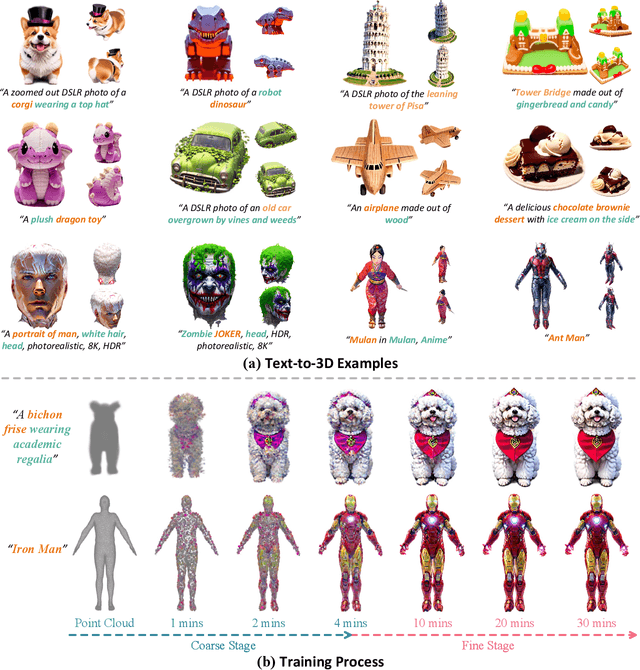

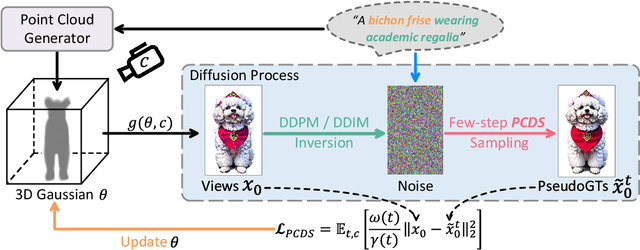
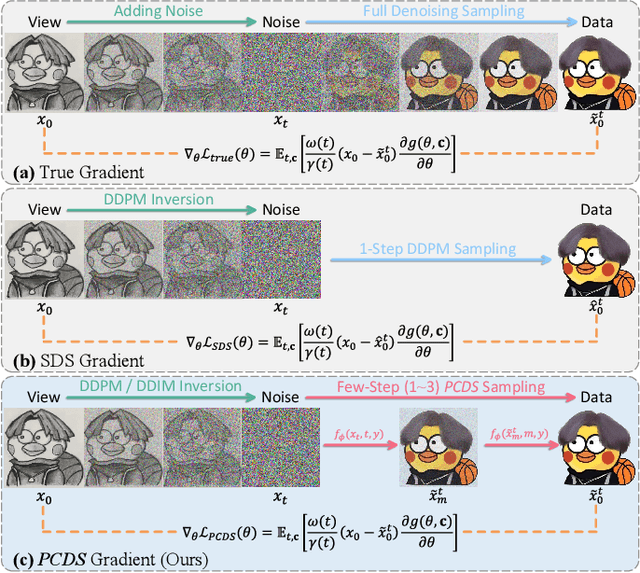
Abstract:Text-to-3D generation aims to create 3D assets from text-to-image diffusion models. However, existing methods face an inherent bottleneck in generation quality because the widely-used objectives such as Score Distillation Sampling (SDS) inappropriately omit U-Net jacobians for swift generation, leading to significant bias compared to the "true" gradient obtained by full denoising sampling. This bias brings inconsistent updating direction, resulting in implausible 3D generation e.g., color deviation, Janus problem, and semantically inconsistent details). In this work, we propose Pose-dependent Consistency Distillation Sampling (PCDS), a novel yet efficient objective for diffusion-based 3D generation tasks. Specifically, PCDS builds the pose-dependent consistency function within diffusion trajectories, allowing to approximate true gradients through minimal sampling steps (1-3). Compared to SDS, PCDS can acquire a more accurate updating direction with the same sampling time (1 sampling step), while enabling few-step (2-3) sampling to trade compute for higher generation quality. For efficient generation, we propose a coarse-to-fine optimization strategy, which first utilizes 1-step PCDS to create the basic structure of 3D objects, and then gradually increases PCDS steps to generate fine-grained details. Extensive experiments demonstrate that our approach outperforms the state-of-the-art in generation quality and training efficiency, conspicuously alleviating the implausible 3D generation issues caused by the deviated updating direction. Moreover, it can be simply applied to many 3D generative applications to yield impressive 3D assets, please see our project page: https://narcissusex.github.io/VividDreamer.
CoCPF: Coordinate-based Continuous Projection Field for Ill-Posed Inverse Problem in Imaging
Jun 21, 2024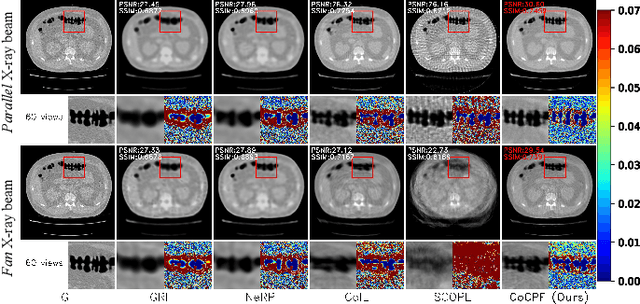
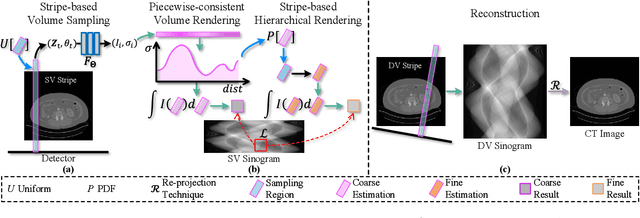
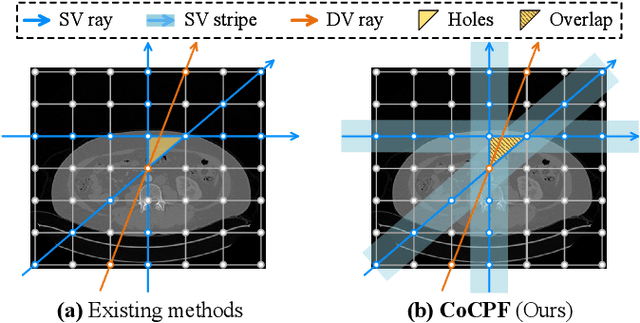
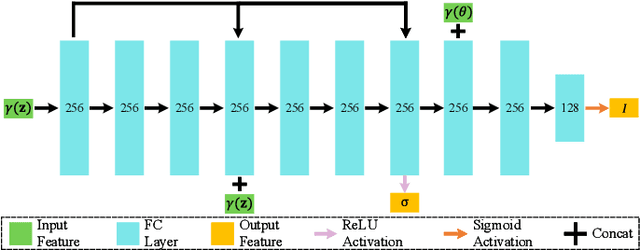
Abstract:Sparse-view computed tomography (SVCT) reconstruction aims to acquire CT images based on sparsely-sampled measurements. It allows the subjects exposed to less ionizing radiation, reducing the lifetime risk of developing cancers. Recent researches employ implicit neural representation (INR) techniques to reconstruct CT images from a single SV sinogram. However, due to ill-posedness, these INR-based methods may leave considerable ``holes'' (i.e., unmodeled spaces) in their fields, leading to sub-optimal results. In this paper, we propose the Coordinate-based Continuous Projection Field (CoCPF), which aims to build hole-free representation fields for SVCT reconstruction, achieving better reconstruction quality. Specifically, to fill the holes, CoCPF first employs the stripe-based volume sampling module to broaden the sampling regions of Radon transformation from rays (1D space) to stripes (2D space), which can well cover the internal regions between SV projections. Then, by feeding the sampling regions into the proposed differentiable rendering modules, the holes can be jointly optimized during training, reducing the ill-posed levels. As a result, CoCPF can accurately estimate the internal measurements between SV projections (i.e., DV sinograms), producing high-quality CT images after re-projection. Extensive experiments on simulated and real projection datasets demonstrate that CoCPF outperforms state-of-the-art methods for 2D and 3D SVCT reconstructions under various projection numbers and geometries, yielding fine-grained details and fewer artifacts. Our code will be publicly available.
 Add to Chrome
Add to Chrome Add to Firefox
Add to Firefox Add to Edge
Add to Edge